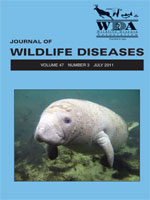Before releasing rehabilitated wildlife, patients should be cured of all infectious agents that pose a risk to free-roaming wildlife or humans after release. Dermatophyte fungi, commonly known as “ringworm,” have zoonotic potential and may be carried as normal flora on the haircoats of certain species. Outbreaks of ringworm are anecdotally reported to occur in white-tailed deer (Odocoileus virginianus) fawns, but no prevalence surveys have been conducted on the haircoat flora of free-roaming individuals. In November 2008, we tested 60 legally hunted white-tailed deer for dermatophyte flora by using a modified MacKenzie technique. Results indicate it is unlikely that wild, mature white-tailed deer in Virginia, USA, carry dermatophyte fungi as normal haircoat flora. Therefore, wildlife rehabilitators and hunters are at low risk for dermatophyte infection by direct contact with this species. In addition, the RapidVet-D 3 Day Test for Veterinary Dermatophytosis was determined to have poor specificity for presence of dermatophyte fungi on asymptomatic white-tailed deer in Virginia.
How to translate text using browser tools
1 July 2011
Survey of Haircoat Fungal Flora for the Presence of Dermatophytes in a Population of White-tailed Deer (Odocoileus virginianus) in Virginia
Natalie H. Hall,
Amy Swinford,
Dave McRuer,
James S. Hall
ACCESS THE FULL ARTICLE

Journal of Wildlife Diseases
Vol. 47 • No. 3
July 2011
Vol. 47 • No. 3
July 2011
cervid
dermatophyte
dermatophytosis
keratinophilic fungi
Odocoileus virginianus
ringworm
white-tailed deer




